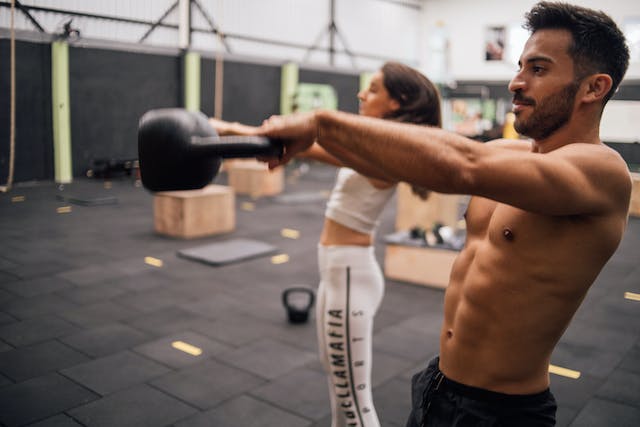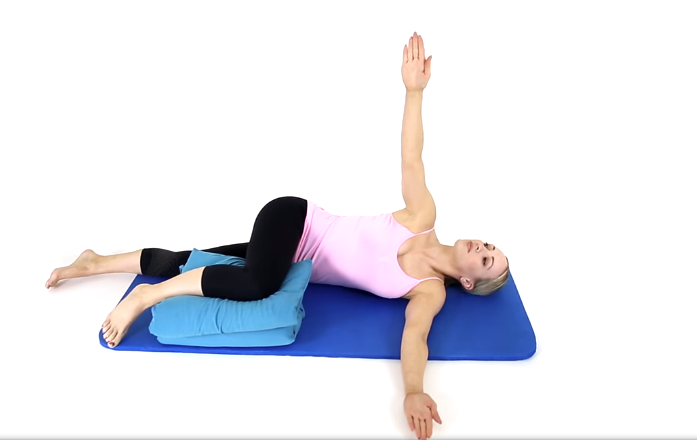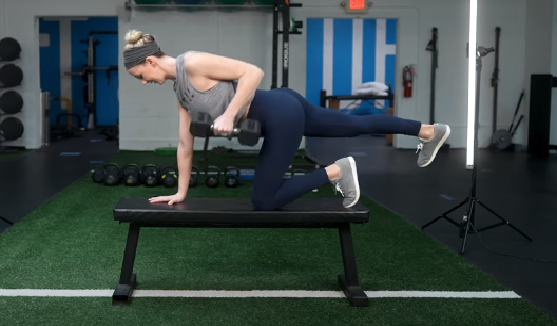If you want to target the muscles of the legs in order to develop and strengthen them, the Barbell Reverse Lunge is a good option as it can be more effective for stretching the quadriceps muscles, as well as the glutes and calves. This exercise helps build lean muscle mass and also helps you to Develop lower body fitness in general.
In this post, we will learn about the correct and safe way to do the Barbell Reverse Lunge exercise, as well as the benefits and mistakes that you must avoid in order to get satisfactory results, as well as avoid the possibility of injury. We will also learn about the variables of this exercise because the variables allow you to target the same muscles differently.
Let’s continue together!
What is a barbell lunge and what is good for?
Barbell reverse lunges is a weight exercise that targets the muscles of the lower body in a complex manner so that it targets a group of muscles, the most important of which are the quadriceps, and occupies more than one joint. This exercise is done by placing a bar loaded with weights behind the neck and doing reverse lunges.
The exercise relies on a push force so that you squeeze your muscles with each repetition to push the weight up. This is what makes the muscles of the legs stretch and squeeze well and remain under pressure with each repetition.
This exercise is suitable for people who want to increase the strength and muscles of the lower body, as it helps you build lean muscle mass, as well as stimulate the muscles to hypertrophy.
- Utility : Auxiliary
- Force : Push
- Mechanics : Compound

Barbell reverse lunge muscle worked
In the Barbell reverse lunge exercise, there are several muscles that are targeted, and the quadriceps muscles are the largest muscle that benefits from this exercise and the most targeted, along with the glutes, adductors and (hamstrings as a stabilizer muscles), in addition to the calves in a secondary way.
Targeted muscle
- Quadriceps : The quadriceps muscles are targeted while extending the knee forward as well as while bringing the knee towards the ground.
Synergist
- Gluteus magnus : The glutes are targeted when the hip joint is rotated and the glutes are well extended backwards.
- Adductor magnus : The adductors muscles work while bending your knees forward, but slightly. If you want to target them more than that, you should go with your extended knee outward slightly.
- Soleus : The soleus is that long muscle that is located next to the back leg (calves). This muscle is long behind the leg and works when you bend your knee and bring it forward.
Stabilizers
- Hamstrings
Learn more about all targeted muscles
How to perform barbell reverse lunges as a pro
Barbell back lunges are an easy exercise and can be done professionally after a few repetitions. For this, you must follow the guide to doing back lunges in order for your movement to be sound and more effective, as well as to avoid injury or muscle stiffness after the end of the exercises.
To prepare :
Standing in front of a rack about chest height, place the barbell over the top of your shoulders, grab the barbell at both sides and keep your palms facing forward.
Executing Barbell Reverse Lunges Correctly:
- Step away from the rack, stand up straight, keep your toes pointed forward and keep your feet close together.
- Keep your back straight throughout the exercise and tighten your grip on the bar well.
- Your elbows should be straight out with your shoulders and your palms facing forward.
- Take a step back, bending the supporting leg.
- Place the forefoot farther back on the ground.
- Bend the knee and hip of the supporting leg until the back knee is almost in contact with the ground.
- Your supporting knee should be at a right angle, and your hidden knee should be directly perpendicular to the floor.
- Stop when you feel the thigh muscles tearing well.
- Return to the standing position by extending the knee of the supporting leg and returning the leg to the back to the side of the supporting leg.
- Repeat again in the same way and train each leg like the other.
Pro tip to improve your barbell rear lunge performance:
It is important to maintain the path of your movement and stay balanced throughout the repetitions. Yes, this exercise helps to improve balance, but it in turn requires some balance because you depend on the leg supporting the diaper in the correct form and not biased to one side, so if you find yourself unable to stay balanced, try To go with light weights, and try to spread your feet a little, and also pay attention to placing the back foot near you, and do not go to a greater depth.
Try to maintain the stability and uprightness of the stump all the time, also with regard to the hips, it may be difficult to bend them if they are not flexible enough, so try to do some warm-up before proceeding with the exercise.
Another thing you have to take care of is the placement of your foot on the ground, your front knee should point in the same direction as the foot during the lunge.
Since we are talking about the lunge, there is a lunge that targets the glutes muscles, which is the long lunge, that is, when you go with the back foot with a big step.
And there is a lunge that targets the quadriceps muscles, that is, when you go with your back knee perpendicular to the ground, and the knee of the supporting foot is at an angle of 90 degrees.
What are the commons mistakes people make during barbell reverse lunge (keep your knee safe)
Barbell back lunges is an effective exercise, but when there are many mistakes at the level of performance, it may become useless and the risk of injury may increase, so it is necessary to have the correct form and technique to do this exercise correctly and safely.
Here are some common mistakes that appear during back lunges:
Excessive forward bending:
It is important to keep your torso straight while doing this exercise, because bending puts the knee under the pressure of excessive weight and it is difficult to control the path of the bar, so you must maintain a straight back so that the weight is almost perpendicular to the pelvis as possible.
You’re bending your knee inward, in a way that is contrary to the position of your foot:
Also, this is a common mistake made by many beginners, and it can put the knee joint under severe tension. The supporting knee is the main pillar that you rely on to push the weight up, and your knee should be directly above your foot and directed in the same direction as the toes.
When you allow your supporting knee to go inward excessively, this raises the possibility of injury to the knee joint, and recovery from this type of injury requires a long time, and this hinders your plans to achieve your goals, so try to avoid this mistake.

Failing to step back enough:
Also, this is a common mistake that may reduce the quality of the exercise and can cause knee pain because you allow your knee to go excessively forward so that it exceeds the level of the toes, i.e. it becomes pushed in front of your toes, so be sure to put a step back enough to keep your knee above the heels while going down.
Rounding your back:
You should practice on keeping your back straight with all exercises, especially with exercises that require carrying heavy weights on your shoulders, such as back lunges, because when you arch the back with that weight that can lead to your spine, so you must keep your back straight and neutral and keep the core engaged throughout the exercise.
Touching the ground with your back knee:
When you do a back lunge, you should go down until the thigh of the supporting foot is parallel to the ground, but do not allow your back knee to touch the ground because this puts more insignificant pressure on your front knee, so keep a few inches between your knees and the ground for better performance.
Barbell rear lunges benefits
Barbell lunges are an excellent addition to building the muscles of the lower body, and there are certainly several benefits that you get when you get used to this exercise.
1 – Build leg strength:
- Back lunges target your leg muscles and as your fitness progresses, your legs will continue to build strength automatically with this exercise.
2 – Improved balance and stability:
- Also, one of the good skills that back lunges can help you build is balance and stability so that it keeps you steady and learn how to rely on your legs to stay stable and control the heavy weight throughout the exercise period and this applies to other exercises that require balance strongly and even in your daily life you will get rid of Some of the problems resulting from the inability to balance.
3 – Improve coordination:
- Back lunges help you improve the coordination between the upper body muscles and the lower body muscles, and this improves the functions of the muscles and the body in general.
4 – Enhances the strength of the core:
- If you engage the core with this exercise well, this will be effective to improve the strength of the latter to improve stability.
5 – Helps burn calories:
- Back lunges are compound exercises that help burn calories (fat) and build lean muscle mass. They target a group of muscles and increase the percentage of calories that are burned during the exercise.
Know more about muscle activation during rear lunges
When to do a barbell reverse lunges
You can do a barbell reverse lunges exercise in the classes designated to target the muscles of the lower body. It can be relied upon in addition to other compound exercises, and it can be a good alternative to some types of squatting exercises in order to impose some diversity in targeting the muscles.
3 Best barbell reverse lunges variations
Reverse lunge with the bar with the front leg raised:
- Place a heavy stool, step, or other elevated surface behind you.
- Stand with your feet hip-width apart and your toes pointing straight forward, holding the barbell behind your back.
- Step back with one foot and place it on the raised surface, keeping your front foot still.
- Lower your body until your back knee is about to touch the floor and your front thigh is parallel to the floor.
- Push through your front foot to return to the starting position and repeat on the other side.
Barbell Reverse Lunge with Shoulder Press:
- Stand with your feet hip-width apart, holding a barbell in front of your shoulders with your palms facing forward.
- Stepping back with one foot, lower your body into a lunge position while simultaneously squeezing the barbell overhead.
- Lower the bar to your shoulders as you push your front foot back to the starting position and repeat on the other side.
Barbell Reverse Lunge with Biceps Curl:
- Stand with your feet hip-width apart, holding the barbell in front of your thighs with your palms facing forward.
- Step back with one foot and lower your body into a lunge position while simultaneously rolling the barbell toward your shoulders.
- Lower the bar to your thighs as you push your front foot back to the starting position and repeat on the other side.
Related posts
Best exercises to unlock hip flexors
Shrimp squat guide for beginners



